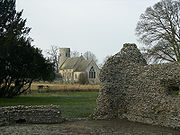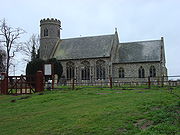
Weeting
Encyclopedia


Norfolk
Norfolk is a low-lying county in the East of England. It has borders with Lincolnshire to the west, Cambridgeshire to the west and southwest and Suffolk to the south. Its northern and eastern boundaries are the North Sea coast and to the north-west the county is bordered by The Wash. The county...
, England
England
England is a country that is part of the United Kingdom. It shares land borders with Scotland to the north and Wales to the west; the Irish Sea is to the north west, the Celtic Sea to the south west, with the North Sea to the east and the English Channel to the south separating it from continental...
.
Its church, St. Mary, stands close to Weeting Castle
Weeting Castle
Weeting Castle is a 12th-century ruin with a three-story-high tower in Weeting, near Brandon, Norfolk, England. Despite the name, it is not a castle but actually a fortified manor house. It has a large open hall and an attached two-storey chamber block. There's a domed brick ice-house on the...
, and is one of 124 existing round-tower church
Round-tower church
Round-tower churches are a type of church found mainly in England, almost solely in East Anglia; of about 185 surviving examples in the country, 124 are in Norfolk, 38 in Suffolk, 6 in Essex, 3 in Sussex and 2 each in Cambridgeshire and Berkshire. There is evidence of about twenty round-tower...
es in Norfolk
Norfolk
Norfolk is a low-lying county in the East of England. It has borders with Lincolnshire to the west, Cambridgeshire to the west and southwest and Suffolk to the south. Its northern and eastern boundaries are the North Sea coast and to the north-west the county is bordered by The Wash. The county...
.
During the 1920s and 1930s, Weeting housed a Ministry of Labour work camp. Basing its operations in the eighteenth century Weeting Hall, the Ministry of Labour opened a residential training centre in 1926, aimed at helping unemployed men - particularly war veterans - to acquire basic agricultural techniques. The centre had a capacity of 200; of these, three quarters were expected to emigrate to countries such as Canada or Australia. The training programme initially consisted of a 'testing period', involving heavy manual tasks such as road-making and log-splitting; those judged suitable were then trained in dairy work, ploughing, horse management, rough carpentry and seed planting.
By 1929, the policy of overseas emigration
Emigration
Emigration is the act of leaving one's country or region to settle in another. It is the same as immigration but from the perspective of the country of origin. Human movement before the establishment of political boundaries or within one state is termed migration. There are many reasons why people...
was under severe pressure. High unemployment in the Dominions led to a sharp decline in demand for freshly trained British workers, and the collapse of mining and heavy manufacturing at home had produced new pressures. Weeting Hall was redesignated as an Instructional Centre, taking in young long-term unemployed men from the depressed areas and giving them a three-month exposure to heavy manual work. The Ministry sometimes described this as a "reconditioning" process, which hardened up young men who had gone "soft" through prolonged unemployment. While some of the trainees did find work as a result, quite significant numbers were either dismissed or walked out - despite the risk to their benefits. Weeting was one of a number of work camps opened by the Ministry rising to a total of 35 by 1938; by the summer of 1939, with unemployment falling as war became imminent, all were closed, and several were turned over to other uses. Weeting Hall, which was used to house wounded Indian and Gurkha soldiers during the Second World War, was demolished in 1954.
Weeting has many thatched cottages and is home to one of the longest continuous lines of thatched roofed houses. Unfortunately in January 2007 the thatched roof caught fire initially only damaging one house, however six weeks later another fire ravaged one half of the whole row. The row is believed to be dated between the eighteenth and nineteenth century.
External links
- Website with photos of Weeting St. Mary, a round-tower churchRound-tower churchRound-tower churches are a type of church found mainly in England, almost solely in East Anglia; of about 185 surviving examples in the country, 124 are in Norfolk, 38 in Suffolk, 6 in Essex, 3 in Sussex and 2 each in Cambridgeshire and Berkshire. There is evidence of about twenty round-tower...
- News.BBC.co.uk n BBC News report about thatched fire.

